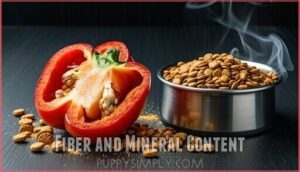This site is supported by our readers. We may earn a commission, at no cost to you, if you purchase through links.

Just skip the seeds and stems—they’re tough to digest and can be a choking hazard. Serve them raw or steamed, but plain is the name of the game—no oils, seasonings, or spices.
Keep portions small, as too much can upset their tummy. Think of red bell peppers as a colorful snack, not a meal.
Curious about how other pepper colors stack up? Let’s explore! Red bell peppers are a great way to add some healthy vitamins to your dog’s diet.
Table Of Contents
- Key Takeaways
- Can Dogs Eat Bell Peppers
- Are Red Bell Peppers Safe
- Nutritional Value of Bell Peppers
- Health Benefits of Red Bell Peppers
- Feeding Guidelines for Dogs
- Bell Pepper Colors and Safety
- Preparing Red Bell Peppers for Dogs
- Frequently Asked Questions (FAQs)
- What happens if my dog eats a red pepper?
- Do bell peppers cause gas in dogs?
- Are dogs allergic to red bell peppers?
- Are red bell peppers safe for dogs?
- What are the risks of feeding bell peppers to dogs?
- Should bell peppers be cooked before feeding to dogs?
- Are bell peppers better for dogs than other vegetables?
- Are frozen bell peppers safe for dogs to eat?
- How often can dogs have red bell peppers?
- Can bell peppers help with a dog’s bad breath?
- Conclusion
Key Takeaways
- Dogs can safely eat red bell peppers when you remove the seeds and stems and keep the portions small.
- Red bell peppers are packed with vitamins A and C, plus antioxidants that boost immunity, skin, and coat health.
- Always serve them plain, without oils, spices, or seasonings, to avoid digestive issues.
- Steaming or chopping them into bite-sized pieces helps prevent choking and makes them easier to digest.
Can Dogs Eat Bell Peppers
Yes, dogs can eat bell peppers, and they’re completely safe when prepared properly. With their crunchy texture and rich nutrients, bell peppers make a healthy, dog-friendly treat in moderation.
Safety of Bell Peppers
Regarding bell peppers for dogs, you’re in luck—they’re safe, non-toxic, and a great, crunchy snack in moderation.
To keep things safe:
- Remove seeds and stems to prevent digestion concerns.
- Introduce slowly to check for pepper allergies.
- Stick to plain preparation; no seasoning, please.
- Watch portion sizes—small amounts go a long way!
This information is crucial for dog owners to ensure their pets can enjoy bell peppers as a healthy snack without any adverse effects.
Toxicity of Spicy Peppers
Spicy peppers like jalapeños or chili peppers aren’t dog-friendly due to their capsaicin content.
Capsaicin effects range from GI irritation to severe toxicity levels, depending on pepper severity and breed sensitivity.
Even small doses can upset your pup’s stomach, causing vomiting or diarrhea, which is why it’s essential to stick to non-toxic vegetables.
Stick to non-toxic vegetables like bell peppers and skip spicy options to keep your dog safe.
Allergies to Nightshade Vegetables
Some dogs might react to nightshade veggies, like bell peppers.
Nightshade sensitivity is rare, but food allergies or intolerances can cause allergy symptoms, such as itching or stomach troubles.
Specific breeds may have a predisposition to allergic reactions. If symptoms appear, seek veterinary consultation.
Instead of red bell peppers, dogs with sensitivities could try alternative vegetables like carrots or cucumbers. Bell peppers also provide antioxidant properties that can boost immunity.
Are Red Bell Peppers Safe
Red bell peppers are safe vegetables for dogs when prepared properly.
They contain zero capsaicin levels, making them a non-spicy option among bell peppers.
However, moderation matters—too much can upset your dog’s stomach.
Always remove seeds and stems to avoid solanine toxicity, and keep an eye out for allergy symptoms like itching or digestive issues, as some dogs react to nightshade plants.
With their low oxalate content, red bell peppers are a worry-free addition to your dog’s diet when served mindfully.
They also offer antioxidant protection from beta-carotene.
Nutritional Value of Bell Peppers
Red bell peppers are packed with essential vitamins like A and C, along with antioxidants that support your dog’s overall health.
Packed with vitamins A and C, red bell peppers are a nutrient-rich, crunchy treat that boosts your dog’s health naturally!
Their high fiber and low-calorie content make them a nutritious and satisfying treat for your furry friend, with antioxidants that are beneficial.
Vitamins and Antioxidants
Red bell peppers aren’t just tasty—they’re packed with antioxidants and vitamins that boost dog health.
They’re loaded with vitamin A for coat health, vitamin C for an immune boost, and beta-carotene for vision.
These vibrant veggies enhance dog nutrition without extra calories.
Plus, antioxidants in red peppers support aging dogs, promoting overall wellness and aiding vitamin absorption naturally.
Fiber and Mineral Content
Red bell peppers for dogs pack a punch with fiber and minerals, helping with digestion regulation and easing dog constipation.
They contain potassium, which supports heart health, and magnesium, boosting energy.
Phosphorus benefits bone strength, while iron absorption guarantees healthy blood cells, and these nutrient-rich veggies keep dog digestion on track while offering a crunch dogs enjoy with potassium and digestion!
Benefits for Skin and Coat Health
Bell pepper nutrition for dogs offers fantastic perks. Red bell peppers, rich in Vitamin A and Beta-carotene, enhance dog skin and coat health.
Their antioxidant effects combat inflammation and aging, while a collagen boost improves skin elasticity. Plus, these peppers promote coat shine, reducing dryness and flakiness.
Here’s why red bell peppers are beneficial:
- Vitamin A improves skin health.
- Beta-carotene fortifies coats.
- Antioxidants reduce aging effects.
- Collagen supports elasticity.
- Prevents dryness or flakiness, which is a critical benefit for dog owners, and overall, red bell peppers provide a natural boost to dog health, making them a great nutritional addition.
Health Benefits of Red Bell Peppers
Red bell peppers pack a powerful punch of vitamins and antioxidants, making them a healthy treat for your dog.
They support immune function, eye health, and even help maintain a shiny coat.
Antioxidant Properties
Packed with antioxidants, red bell peppers give dogs a natural defense against oxidative stress and inflammation.
Red bell peppers provide a nutrient-packed shield, protecting dogs from oxidative stress while boosting overall wellness and vitality.
These nutrients, like vitamin C and beta-carotene, promote cellular protection and may even aid in cancer prevention.
By fighting inflammation, they also support joint health, particularly in aging dogs, and it’s like serving your pup a little superhero snack disguised as a colorful vegetable, which can be considered a natural defense.
Eye Health and Vision
A colorful bonus for your dog’s eyes, red bell peppers pack a punch of lutein and beta-carotene, which convert to vitamin A, essential for vision.
These antioxidants protect cells from degeneration, keeping eyes sharp and healthy.
If your pup enjoys this vibrant treat, it’s a win for their eye health and overall well-being—a snack with real bite!
Immune System Support
A strong immune system keeps your dog wagging through life, and red bell peppers can help.
These vibrant veggies offer an antioxidant boost with vitamin C benefits that reduce inflammation while supporting cellular protection.
Curious how red bell peppers benefit dogs? Check this list:
- Disease prevention support.
- Boosts immunity with Vitamin C.
- Antioxidants enhance overall health.
- Reduces inflammation naturally.
- Promotes cellular health.
Red bell peppers provide a natural way to support your dog’s health, making them a great addition to their diet for overall wellness.
Feeding Guidelines for Dogs
If you’re thinking about sharing red bell peppers with your dog, it’s important to serve them the right way.
Removing seeds and stems, preparing bite-sized pieces, and sticking to small portions can help keep your pup happy and healthy.
Removing Seeds and Stems
When serving red bell peppers to dogs, always remove the seeds and stems first.
These parts contain solanine, which, while not deadly in small amounts, can be harmful in large quantities.
Seeds and stems can also pose choking hazards or lead to indigestion, making this step vital for pet safety.
By focusing on preparation importance, you can guarantee a safe and enjoyable treat for your pup.
Like grass seeds, which can cause painful paw swelling, bell pepper seeds can also lead to discomfort if ingested.
Remember, serving size matters—offer red bell peppers in moderation to avoid upsetting their stomach.
Are bell peppers safe? Yes, just prep them properly!
Preparation Methods
When preparing red bell peppers for dogs, stick with simple, safe methods. Always remove the seeds and stems first, as they can cause indigestion.
For easier chewing and digestion, consider steaming or pureeing the peppers—both cooking methods preserve nutrients. Chop them into bite-sized pieces to prevent choking, especially for smaller dogs.
Avoid adding butter, oils, or spices (safe additives like plain water are best). Store leftovers in an airtight container in the fridge for freshness.
Red bell peppers are a great addition to a dog-safe vegetables list when prepared correctly! Many owners utilize a steamer for preparation.
Bell Pepper Colors and Safety
You might wonder if all bell pepper colors are safe for your dog, and the good news is they are.
Whether it’s green, yellow, orange, or red, these peppers are non-toxic and can be a healthy treat when prepared properly.
Green Bell Peppers
Green bell peppers are safe for dogs and provide fiber for digestive health.
However, moderation is key to avoid potential side effects like upset stomachs.
Follow these dog health tips for feeding green peppers:
- Remove seeds and stems for safety.
- Serve raw or lightly steamed for easy digestion.
- Introduce slowly to monitor reactions.
- Avoid seasoning or additives.
Yellow Bell Peppers
Yellow bell peppers, while not as hyped as red ones, are a great addition to your dog’s diet.
Packed with vitamin C, lutein, and zeaxanthin, they support eye and immune health.
Always feed in moderation to prevent tummy troubles.
Need a quick reference? Check out the handy table below for benefits:
| Nutrient | Benefit | Why It’s Great |
|---|---|---|
| Vitamin C | Boosts immunity | Keeps dogs healthier |
| Lutein | Supports vision | Brightens doggo eyes |
| Zeaxanthin | Eye protection | Reduces eye strain |
| Fiber | Better digestion | Smooths potty breaks |
They provide several key health benefits, including better digestion and eye protection, making them a nutritious snack for dogs.
Orange Bell Peppers
Orange bell peppers are a tasty, safe vegetable for dogs.
They are packed with beta-carotene and vitamin A benefits, which support eye and immune health.
While not as nutrient-dense as red bell peppers, dogs can enjoy them in moderation.
Remember these tips:
- Remove seeds and stems.
- Serve as a treat alternative, raw or pureed.
- Avoid spicy oils or seasonings.
Preparing Red Bell Peppers for Dogs
Preparing red bell peppers for your dog is simple but requires a little care to keep them safe and tasty.
From steaming to serving raw, you’ll want to avoid seasonings and remove any seeds or stems.
Steaming and Pureeing
Steamed bell peppers and pureed peppers are great additions to your puppy’s diet, boosting digestion ease and nutrient retention.
Softening the peppers through steaming enhances palatability, especially for small or older dogs with sensitive teeth.
Pureeing is a versatile preparation method, easily mixed into recipe ideas or regular dog food preparation, supporting your pup’s digestive health while keeping meals enjoyable.
Bell peppers are also packed with essential vitamin C, which helps boost your dog’s immune system, providing a great way to keep your pup healthy with essential nutrients.
Raw or Cooked Peppers
Raw red bell peppers are crunchy and full of nutrients, but cooking them can soften the texture for easier chewing.
To decide between the two, consider these points:
- Raw benefits: Maximum nutrient retention.
- Cooking methods: Steaming preserves vitamins.
- Digestion concerns: Cooking helps sensitive tummies.
- Palatability issues: Some dogs prefer cooked peppers’ mild sweetness.
Choose what works best for your pup!
Avoiding Seasonings and Additives
When preparing red bell peppers for dogs, skip seasonings.
Salt toxicity is a real risk, and onion dangers or garlic concerns make additives a no-go.
Spices cause irritations, so stick to safe alternatives.
Red bell peppers are a fantastic dogsafe food, but keep them plain.
Many owners prefer unseasoned dog food for sensitive stomachs.
Simple, unseasoned vegetables are the safest choice for a healthy dog diet.
Frequently Asked Questions (FAQs)
What happens if my dog eats a red pepper?
Red bell peppers pack nine times more beta-carotene than green ones, supporting your dog’s vision and immunity.
They’re safe if seeds and stems are removed, but start slow to prevent upset tummies.
Always monitor them!
Do bell peppers cause gas in dogs?
Bell peppers can sometimes cause gas in dogs, especially if eaten in large amounts or introduced too quickly.
Start slowly, monitor your pup’s reaction, and always remove seeds and stems to avoid digestive trouble.
Are dogs allergic to red bell peppers?
Think of red bell peppers as a friendly neighbor—most dogs tolerate them well, but a few might’ve allergies.
Watch for itching, vomiting, or diarrhea after feeding them.
Always introduce slowly to guarantee safety.
Are red bell peppers safe for dogs?
Dogs can safely enjoy red bell peppers in moderation.
They’re packed with vitamins and antioxidants, making them a nutritious treat.
Just remember to remove the seeds and stem, and don’t feed them spicy peppers instead!
What are the risks of feeding bell peppers to dogs?
Imagine your dog loving a crunchy snack but later facing stomach trouble.
Overfeeding bell peppers or including stems and seeds can cause vomiting, diarrhea, or indigestion.
Always serve plain, in moderation, and seed-free!
Should bell peppers be cooked before feeding to dogs?
You don’t have to cook bell peppers for dogs, but steaming them can make chewing and digestion easier, especially for older pups.
Avoid frying or seasoning—keep it plain and simple for your furry friend!
Are bell peppers better for dogs than other vegetables?
In the context of vegetables, bell peppers are like hitting the jackpot—they’re nutrient-rich, low-calorie, and packed with vitamins A and C.
While other veggies offer benefits too, bell peppers stand out for immune and skin support.
Are frozen bell peppers safe for dogs to eat?
Frozen bell peppers are safe for dogs, but let them thaw first to prevent choking or tooth issues.
Avoid seasoned or mixed varieties.
Moderation is key, and always remove seeds and stems before serving, with moderation being essential to ensure the dog’s safety.
How often can dogs have red bell peppers?
Red bell peppers pack nine times more beta-carotene than green ones, making them a super-nutritious treat.
Give them to your dog 2-3 times a week in moderation, ensuring seeds and stems are removed first.
Can bell peppers help with a dog’s bad breath?
Bell peppers won’t magically cure your dog’s bad breath, but their crunchiness and vitamin C can aid oral health.
Pair them with regular dental care for fresher kisses—they’re a healthy snack, not a breath mint!
Conclusion
Did you know red bell peppers have nearly 11 times more beta-carotene than green ones?
That’s a big boost for your dog’s health! Adding red bell peppers to your pup’s diet is a safe, nutritious choice—just stick to small portions and avoid the seeds and stems.
Serve them raw or steamed, always plain, for maximum benefits. In the case of colorful snacks, red bell peppers shine as a tasty, vitamin-rich treat for your furry friend, providing a great way to give them a healthy boost!

















